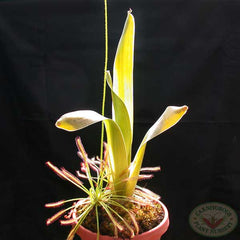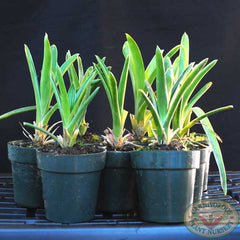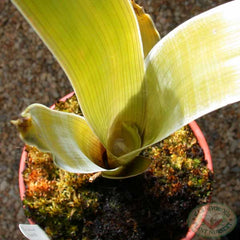
Growing Tips for Bromeliads



Carnivorous Bromeliads - Brocchina spp. and Catopsis spp.
Soil: 1:1 sand:peat mix.
Container: 4-6" plastic pot.
Watering: moist, not wet.
Light: full to part sun.
Temperature: cool.
Humidity: medium to high.
Location: windowsill, terrarium, greenhouse, outdoors.
Dormancy: no.
Habitat
The Carnivorous Bromeliads, such as Brocchinia reducta, are terrestrial Carnivorous Plants native to the Guiana Highlands of South America. It is a companion plant to Heliamphora and like them, they grow in the low lying depressions and crevices among other bog plants such as ferns, horsetails and heath in the more barren soils of a sandy peat mix. The climate is windy, misty, foggy, and cool year round with typical daily temperatures between 46-68°F (8-20°C). Throughout the year temperatures can range between 34-90°F (1-32°C). There is abundant rainfall of 80-100”/year (200-400 cm). The nights are cold, winter frosts are common, but it rarely freezes. Companion Carnivorous Plants include Heliamphora, Drosera, Utricularia, and Genlisea.
Culture
Brocchinia reducta can be a challenging Carnivorous Plants to grow because of its need for bright and cool conditions. This is a difficult combination for many growers. It prefers good air circulation and a light, well-drained, porous soil. A soil mix of 1 part perlite, and 1 part peat works well. Keep the soil evenly moist. Water with mineral-free water from overhead, and avoid having the pots stand in water for very long. A deep pot of 4-6+” (10-15+cm) will help keep the roots out of water. B. reducta prefers full bright sun and cool temperatures. A day/night temperature difference of 10°F (5°C) is recommended. Keep the bottom of the tube filled with rain or distilled water.
Dormancy
B. reducta does not require dormancy. Provide cooler winter temperatures though. Slow growth during the winter months is typical.
Feeding
The Carnivorous Bromeliad only needs to “feed” about once a month during active growth. Provided with natural access to insects they will “feed” themselves. Even indoors they will attract and capture an occasional fly or other insect. Do not feed them meat or cheese. This will likely rot and kill the trap. If feeding is desired, drop in a few dead crickets, wasps or similar insects. Freeze dried food from the pet shops works well.
Other Considerations
B. reducta will readily send up pups (young plants) near the plant base. Once they develop roots, they can be cut off from the mother plant are repotted.
